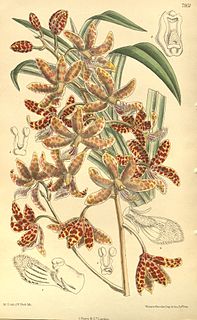
Dipodium, commonly known as hyacinth orchids, is a genus of about forty species of orchids native to tropical, subtropical and temperate regions of south-east Asia, New Guinea, the Pacific Islands and Australia. It includes both terrestrial and climbing species, some with leaves and some leafless, but all with large, often colourful flowers on tall flowering stems. It is the only genus of its alliance, Dipodium.

Dipodium roseum, commonly known as rosy hyacinth-orchid or pink hyacinth-orchid, is a leafless saprophytic orchid found in east and south-eastern Australia. In summer it produces a tall flowering stem with up to fifty pale pink flowers with small, dark red spots. A widespread and common species it is often confused with D. punctatum but has darker, less heavily spotted flowers.
Cordiglottis is a genus of flowering plants from the orchid family, Orchidaceae. It contains 7 known species, all native to Southeast Asia.
- Cordiglottis breviscapa(Carr) Garay - Pahang
- Cordiglottis filiformis(Hook.f.) Garay - southern Thailand, peninsular Malaysia, Sabah
- Cordiglottis fulgens(Ridl.) Garay - peninsular Malaysia
- Cordiglottis major(Carr) Garay - peninsular Malaysia, Sabah
- Cordiglottis multicolor(Ridl.) Garay - Sarawak
- Cordiglottis pulverulenta(Carr) Garay - Pahang, Sabah
- Cordiglottis westenenkiiJ.J.Sm. - Borneo, Sumatra

Thelasis, commonly known as fly orchids, is a genus of flowering plants from the orchid family, Orchidaceae. Plants in this genus are usually epiphytes, sometimes lithophytes or rarely terrestrials. Some species have pseudobulbs with up to three leaves, whilst others have several leaves in two ranks. A large number of small, white or greenish yellow flowers are borne on a thin, arching flowering stem. There are about thirty species, distributed from tropical and subtropical Asia to the southwest Pacific.

Dipodium variegatum, commonly known as the slender hyacinth-orchid, or blotched hyacinth-orchid, is a leafless mycoheterotrophic orchid that is endemic to south-eastern Australia. It forms mycorrhizal relationships with fungi of the genus Russula.

Dipodium stenocheilum, commonly known as tropical hyacinth-orchid, is a leafless saprophytic orchid that is endemic to northern Australia. For most of the year the plant is dormant but in summer it produces a tall flowering stem with up to twenty five white flowers with purple spots and a mauve labellum.
Dipodium brevilabium is an orchid species that is endemic to Western Papua in Indonesia. The species was formally described in 2009.
Dipodium fevrellii is an orchid species that is endemic to Sulawesi in Indonesia. The species was formally described in 1933 by Dutch botanist Johannes Jacobus Smith.
Dipodium bicallosum is an orchid species that is native to Peninsular Malaysia and Sumatra in Indonesia. The species was formally described in 1927 by Dutch botanist Johannes Jacobus Smith.
Dipodium purpureum is an orchid species that is native to Borneo. The species was formally described in 1910 by Dutch botanist Johannes Jacobus Smith.
Dipodium conduplicatum is an orchid species that is native to Peninsular Malaysia and Sumatra. The species was formally described in 1927 by Dutch botanist Johannes Jacobus Smith.

Dipodium pictum, commonly known as brittle climbing-orchid or climbing hyacinth-orchid, is an orchid species that is native to Malesia and the Cape York Peninsula in Australia.
Dipodium elegans is an orchid species that is native to Sumatra in Indonesia. The species was formally described in 1900 by Dutch botanist Johannes Jacobus Smith.
Dipodium gracile is an orchid species that is native to Sulawesi in Indonesia. The species was formally described in 1911 by German botanist Rudolf Schlechter.
Dipodium fragrans is an orchid species that is native to south-east Asia. It was formally described in 2006. It occurs in Sumatra, Peninsular Malaysia, Borneo and Sulawesi.

Dipodium paludosum is an terrestrial orchid species that is native to south-east Asia. It occurs in Cambodia, Thailand, Vietnam, The Philippines, Sumatra, Peninsular Malaysia and Borneo. The leaves up to 30 cm long and 2.5 cm wide. The axillary racemes comprise 6 to 12 fleshy flowers which are each up to 4 cm wide and are cream with purple-magenta spots.
Dipodium scandens is an orchid species that is native to Malesia.
Dipodium squamatum is a mycoheterotrophicorchid species of the tribe Cymbidieae.
Gastrodia javanica or Javanese Chijian is an epiparasitic species of orchid native to Singapore, the Philippines, Indonesia, Malaysia, and Thailand. The species normally grows to a height of 20 to 80 centimeters, and has pale yellow or green-yellow flowers.
Thrixspermum carinatifolium, commonly known as the Christmas Island hairseed, is an epiphytic orchid with flattened, straggly stems that form clumps with many branching aerial roots. It has flattened fleshy leaves arranged in two ranks along the stems and white or yellowish, widely opening flowers. This orchid occurs from Peninsular Malaysia to Christmas Island, an Australian territory.









